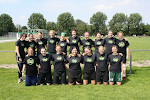Fitness and Injury Prevention
Jamie “Idaho” Arambula
Ultimate is a weird sport where you can get a very eclectic mix of people from different sports across
the board. (I did track and boxing before my career started.) Because of that there are very different
approaches to what people think regarding fitness and preparation for a college ultimate season.
What may not be obvious to everyone is how closely linked fitness and injury prevention are. In a
perfect world, there would be one cookie cutter method to fitness and conditioning where everyone
would be physically peaking come Regionals, or Nationals. Unfortunately, this is the real world where
injuries, and time constraints exist.
My philosophy to fitness and injury prevention is centered around the fact that think that muscle
memory is a huge factor to success. My thoughts are that you are less likely to get hurt if your body
has some recognition to what you're asking it to do. When someone has to stop to turn for a disc
thrown behind them and they make the awkward stop and twist, people's bodies tend to say, 'Hey,
what's this motion? I'm not used to this!', and then 'pop' something gives.
However if you can start from day one replicating the type of full speed direction change motions,
SLOWLY at first, to teach the body the proper mechanics, then the chances are much less that you
initiate a 'system shock'. This is an easy solution with footwork, reaction, and receiver scenario drills.
Do some form of these drills EVERY PRACTICE so that by the time mid season arrives the body does
them without thought. It's extremely rewarding the first time a player realizes that they've just
'dropped and chopped' without a second thought about it.
In drills, it's important to make sure that both defensive and offensive footwork is taken into account.
Defensive footwork is much more tied into reaction, and those aspects can be added to footwork
drills, then integrated into game-like drills.
I don't like to waste practice time with conditioning. I think any success oriented team needs to have
separate conditioning hours, whether it's mandatory tracks, or pod-style workouts.
To get fast, there is no substitute for sprinting, both full recovery, sprint, and recovery- type running. I
truly believe that 'ultimate shape' is really just a matter of how much time you take to recover.
Tabata style conditioning (sprint intervals 20 seconds on / 10 seconds off) is brutal but very effective.
Also you can integrate footwork tabatas as an 'active recovery.'
Proper running form is the foundation for speed. It's nice to be given feedback or to run a set of 'sprint
form progressions' to teach the habits that make sprinters even faster.
If you want to be super technical, you can split your conditioning workouts into 'on track', and 'in
cleats' phases. Even more technical than that is to split into 'handler' and 'cutter' pods / groups to
condition using the sprint length and recovery time to replicate your style of play.
After the mid-point in the season, I think it's useless to run 400 or even 200 meter workouts during
conditioning. There is no point on the field where I replicate that sprint form, or time, so why would i
allocate time to teach my body that, instead of sprint 30 cut back 10 sprint 30? The latter replicates
the style of lane cutter running, and recovery depending on number of reps.
Even if some players do not have access to a local gym, I think it's important to have a weight or
isometric type strength program with the objective of keeping the shoulders, knees, and ankles
supported throughout the season, as a supplement to all the track work.
In summary:
• Fitness and injury prevention are closely intertwined
• Muscle memory, balance, and reaction are important aspects to injury prevention
• Certain drills should be integrated into every practice/warm up in order to cultivate muscle
memory
• Practice time is not conditioning time. A separate conditioning time is necessary to maximize
full team meetings
• You can be faster by improving on body mechanics/running form
• Sprinting, and footwork drills with variable recovery, and reps will serve the players better than
longer-than-ultimate type runs
• A supplemental strength program to keep shoulders, knees, ankles supported is never a bad
idea
Pages
About Us
Women's Ultimate in Ireland has been progressing over the last number of years to what is now a competitive, fun and active scene for a horde of players, both new and old. With two womens clubs underway in 2010 for the first time ever, we can look forward to even more competition and a raising of what is already an impressively high standard of play.
Monday, August 9, 2010
Subscribe to:
Posts (Atom)
